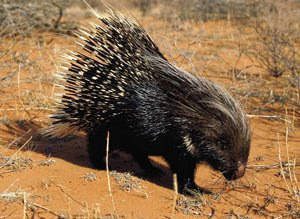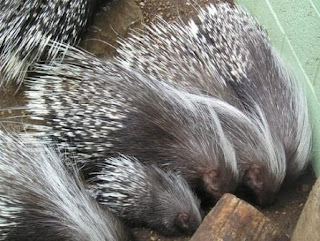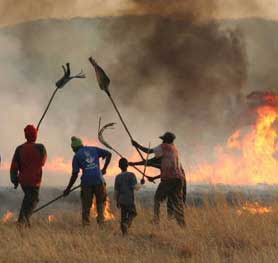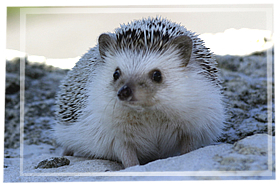This is the world of the ‘Black Eagles of Roodekrans’ at the Walter Sisulu Botanical Gardens in Roodepoort, Gauteng, South Africa. Weighing up to 4.8 kg this is one of Africa’s largest and most spectacular eagles. - These are certainly the masters of the sky!
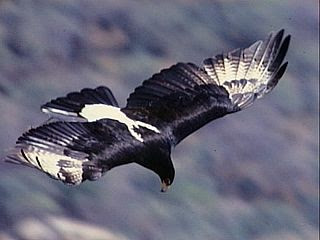
The Black Eagle Cam is situated in the Walter Sisulu National Botanical Gardens, in Johannesburg, South Africa. The camera is a joint project supported by a number of sponsors including Africam. The projects aims are to create awareness and support for the Black Eagle Project. In 1998 the Black Eagle Project was set up as an affiliated to the Walter Sisulu National Botanical Garden and was registered as an independent, Section 21, non-profit organization.
 Black Eagle Cam at the Walter Sisulu Botanical Gardens keeping an eye on the nest - Recently the web cam components were stolen and repairs are under way
Black Eagle Cam at the Walter Sisulu Botanical Gardens keeping an eye on the nest - Recently the web cam components were stolen and repairs are under wayThe project consists of a 7 member committee and approximately 30 dedicated volunteer members. What is so significant about this project is that these eagles are the last of a once much larger population that inhabited the mountain ridges of Johannesburg.
The aims of the project at that stage were : -
- To educate and inform the public about the Black Eagles and raptors in general.
- To conserve and secure the Black Eagles in the Walter Sisulu (Witwatersrand) National Botanical Garden for future generations to enjoy.
- To monitor and obtain vital information on their breeding cycle.

In 1998, Black Eagle Monitoring Project (BEMP) broke away from Raptor Conservation Group and became affiliated to the Walter Sisulu (Witwatersrand) National Botanical Garden. The project was renamed the Black Eagle Project Roodekrans (BEPR) and was registered as a Section 21, non- profit organisation, with its own constitution, bank accounts and appointed auditor. The project consists of a 7-member committee and approximately 30 dedicated volunteer members.
 The ringing process
The ringing process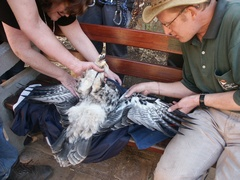 Doing wing measurements
Doing wing measurements Due to the expansion of the city of Johannesburg their habitat and food source has come under threat. This specific nesting site has been documented as far back as the early 1940’s and it is estimated that the current mating pair are the third or fourth descendants from the first documented nesting pair.
 Black Eagle pair, Emoyeni and Thulane
Black Eagle pair, Emoyeni and Thulane Black Eagle on his way to the nest with nesting material
Black Eagle on his way to the nest with nesting material The precious egg
The precious eggIt remains quite incredible how the Roodekrans pair have tolerated the rapid rate of urbanisation and development within their immediate hunting area. The influx of visitors to the Garden, noise, lack of prey and competing against the elements must surely challenge their existence. The interference within and around the territory has escalated with stray and domestic dogs and vagrants being largely responsible for the reduction of their principal prey base, the Dassie (Rock Hyrax). The eagles have had to adapt their prey base to include guinea fowl, francolin, red rock rabbit and in desperation the easiest prey – chickens, although this does not happen very often.

The recording of information on the Roodekrans eagles started on a very ad hoc basis by Dr. Gerhard Verdoorn of the Raptor Conservation Group, in 1988, which progressed to become a school study project by Albert Froneman. In 1992 Albert Froneman, Rob Harrison-White, Chris van Rooyen and Sally Panos, the latter serving on the committee at this time, initiated the Black Eagle Monitoring Project. The project was then a working group of Raptor Conservation Group.
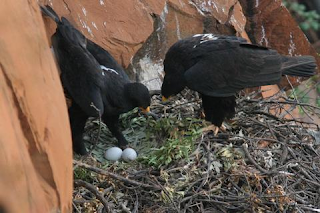 The Black Eagles on their nest with the two eggs
The Black Eagles on their nest with the two eggsLocation and subject matter
The Walter Sisulu National Botanical Gardens, are nestled in the Crocodile River Valley that cuts through the Roodekrans mountain ridge. As a back drop to the gardens and a main geological feature along the ridge is a conspicuous red cliff face that forms the Witpoortjie waterfall. These cliffs are an ideal habitat for the Black Eagles and other animals in particular the rock Dassie or hyrax that can account for as much as 90% of their diet in some areas. It is estimated that a breeding pair can consume around 400 Dassies / year, so it is not hard to see how with the increase in urbanization, and habitat destruction how the whole food chain is put under threat.
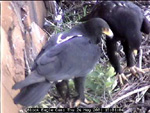
Black Eagles form life long mating bonds. The current female estimated to be between 35 to 40 years old, known as Emoyeni, (upon the wind) was first sighted in the early 1970’s, and has successfully reared a number of offspring. Her current mate Thulane (The shy one) is much younger and replaced her last mate that vanished back in 1998. The pair have over the years built a number of nesting sites on the cliff face where a pan tilt zoom camera has been installed to document there progress and behaviour in an effort to better understand these animals.
Although, Black Eagles pair for life, they will replace their companion. In the Roodekrans scenario the female, Emoyeni replaced her mate 3 times after 2 of them disappeared. Eagle pairs spend approximately 95% of the daytime together, before nest refurbishment; this is a behavioural characteristic of black eagles. They will perch, fly and hunt together, should the female fly to the nest site the male will follow and usually hops onto the surrounding rocks. After eggs are laid and when there is a young chick on the nest paired black eagles spend very little time together. During nest building 77% of their time is spent together but this decreases dramatically to 6% during incubation. As the young eaglet grows the time spent together by black eagle pairs gradually increases again.
When to viewThe eagles live permanently in the area throughout the year, but the best time to catch them on the camera is between mid March through to the end of September each year. Egg laying normally occurs in Mid May followed by a lengthy incubation period of 44 to 45 days. The cam runs during daylight hours only between 7am and 6pm Central African Time (times are subject to change due to change in sun rise and sun set), the images are normally refreshed at 30-second intervals. Visitors to the botanical gardens will be able to view live video from the nest in the visitors centre. For more information regarding these eagles please check out the following website: www.blackeagles.co.za
 QUATELE "THE CROSS ONE"
QUATELE "THE CROSS ONE"The previous male eagle was admired by all who watched him and his memory will remain with everyone who knew him for many years to come. Each individual eagle carries his own identity and their own distinct features – Quatele looked so fierce with his over-hanging eyebrow, hence the name “the cross one” any prey would dive for cover. Monitors and volunteers carried out an intensive search in the surrounding area, but no trace was found. We have no idea what happened to Quatele – we can only presume that he was either shot, poisoned, captured or died of natural causes, but wherever you may be,
"May you always soar on great wings of destiny!" EMOYENI"UPON THE WIND"
EMOYENI"UPON THE WIND"The grand old lady is probably over 40years old and is loved by many who have followed her life cycles with passionate interest. The first sightings of Emoyeni were in the early 1970's with her first mate; unfortunately we do not know anything about him. Quatele was her second mate and she scoured the ridges searching for him when he disappeared in 1998. Emoyeni patiently taught her third mate Thulane everything she knew, tolerating his initial shortcomings, but now appreciating his newfound expertise. Many a lesson could be learnt from this magnificent black eagle.
"May the wind always be beneath your wings!!" THULANE"THE SHY ONE "
THULANE"THE SHY ONE " The joyful outcome of 1998 was the arrival of the new male, just sexually mature, shy and inexperienced. Barely in his first year of adulthood, as he was small in length and wingspan, the “V” on his back was not quite developed and his inside leggings were still pale. He still had so much to learn, his insecurities with mating and nest building showed, but there again he had a patient teacher – Emoyeni. However, “the shy one” has proved to be a good pupil and has matured into a mighty species.
"He is Emoyeni's mate for life now." HOW CAN YOU HELP?Poisoning There are many poisons used by man that affect raptors - the farmers use poison for "problem animals" such as the black-backed jackal, caracal, leopard or cheetah from ravishing their stocks, this causes major problems when scavenging raptors like Bateleurs and vultures eat the bait or poisoned animal. Organochlorine pesticides build up in a food chain and unfortunately many raptors being at the end of that chain, eat the poisoned prey and will most certainly face death.
In agricultural pest control Organophosphates have replaced Organochlorines, as they are believed to break down much faster, whereas the Organochlorines remain stable and are stored in the animals fat. Where humans are concerned the organophosphate can be lethal. Insecticides of today, such as parathyroid and carbonates are highly toxic to birds but not to mammals. Secondary poisoning in birds can occur, however, when carbonates are used in the control of termites, as the birds eat termites. Low levels of Organochlorines ingested by raptors over a period of time results in egg breakage, shell thinning and embryos dying in unbroken eggs, thus causing a decline in raptor population and extinction in certain areas. Always use an environmentally product like "Racumin" in the control of rodents.
Natural habitatThe basic requirements are a reliable food source and an undisturbed nesting site. Fortunately an increasing number of landowners now protect and preserve their eagles, as they have come to realise the benefits of eagles in their territory. Eagles have an exceptional ecotourism value, as bird watching is one of the fastest growing pastimes in South Africa. Diversity of habitat results in a rich and dense fauna. Mountain populations of black eagles have a higher nest density and breeding success compared to open area populations. At the present time, in this country, there are lengthening lists of endangered species and degraded ecosystems, which never heal.
The environment must be protected, to prevent extinction of animals and plants.
Power lines
All raptors are attracted to power lines, as they utilise them for hunting, nesting, roosting and feeding perches.
As they are so vulnerable to electrocution these power lines can be hazardous to eagles, if the phase conductors are separated by less then the wingspan of the eagle, the bird can be electrocuted while landing or taking off, or if the distance between an earth-wire and an energised conductor is less than the wingspan or the distance between tip of the bill to tail tip. The eagle's age, experience, the weather, or season may also affect the susceptibility of the eagle. Inexperienced eagles may also collide with the conductors in flight, but this risk is lower then electrocution. Landowners are requested to report eagles roosting on lines, plus dead eagles found under the power lines, to assist Eskom in taking steps to minimise electrocutions. Eskom, in association with EWT are world leaders in the development of various products to insulate conductors, thus reducing deaths to sustainable levels.
Hunting
Black eagles must be one of the most persecuted eagles in the world, due to the fact that some farmers feel justified that they kill small livestock. This is, in fact, very rare, and the South African public are now aware, due to various media articles, of the relentless killing of these eagles by stock farmers, for decades. Farmers are now encouraged to tolerate these raptors and accept their beneficial, ecological function in farming ecosystems, particularly in the control of Dassies, which compete with livestock for grazing. There is a huge ecological impact to the healthy ecosystem by the killing of raptors.
Removal of eggs and chicksEagles are not aggressive to humans unless they themselves or the contents of their nests are threatened. Hand reared eaglets are likely to be more aggressive to humans and
are more difficult to handle than wild ones. Chicks handled by humans are imprinted, which is a serious handicap to successful rearing and then they are unable to return to the wild. Severe damage can be done to a chick if fed on an incorrect diet - damage that is irreversible.
GO HERE
http://www.blackeagles.co.za/google.htm> to get a bird's eye view of the nesting and surrounding area.
(Most of this information was compiled from the
Black Eagle Cam Project Website )











